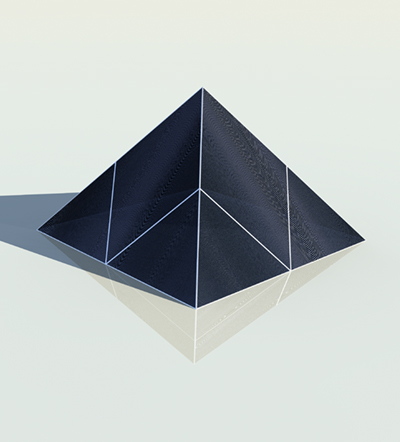
Image Courtesy of Robert Flottemesch. (Click for slideshow)

While the people of Egypt are anticipating a bold new future for their country, thanks to the powerful protests by demonstrators in recent weeks, an American artist has been recognized for his exciting plan to bring future-minded energy of a different sort to the Middle East.
Robert Flottemesch and his team of collaborators received the Land Art Generator Initiative’s grand prize last month for the design of Lunar Cubit, a blueprint for a 50-meter-tall solar paneled pyramid surrounded by eight 22-meter-tall pyramids, each of which represents a different phase of the lunar calendar. The intended construction site is five kilometers from Abu Dhabi’s international airport in the United Arab Emirates, the host country of the World Future Energy Summit, where the prize was presented. Flottemesch accepted the award with his landscape designer Johanna Ballhaus, his artistic consultant Jen DeNike, and Adrian De Luca, who helped develop the project’s data monitoring system.
Making use of the design template left by the ancient Egyptians was a longstanding goal of Flottemesch’s. “Ever since I visited the pyramids when I was much younger, the mystery that has surrounded them and the scope of the engineering has been something that I find quite significant,” he tells PLANET.
(more…)
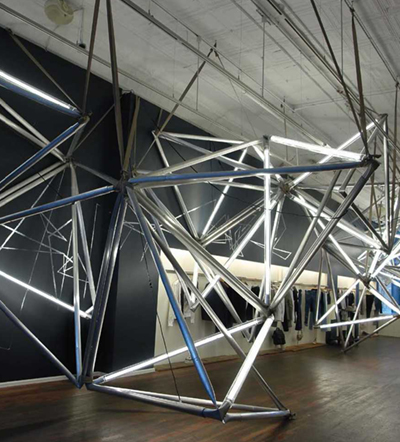
AUTOMATIC Automatic, New York, USA, by Formavision. Copyright Gestalten 2010. (Click for Slideshow)

Everyone knows how it feels to walk down a city street that they’ve walked down many times before only to find that a familiar shop or restaurant has disappeared, been remodeled beyond recognition, or replaced with something new. Although we accept these spaces as fixed elements of our environment they’re really quite ephemeral. Even if a building survives for hundreds of years, it’s refashioned again and again to suit changing needs and tastes.
A new book, “Staging Space,” spotlights some impactful contemporary interiors whose power lies in their theatricality — in the assertive way that they shape the way we live, work and entertain ourselves. The designs featured in the book don’t hold back, using the boldest geometries, colors, and lighting to hold a visitor’s attention. This strategy works best in spaces that people spend a limited amount of time inside of, like stores and restaurants. A denim shop in New York City gives over its central space to an enormous, tree-like light sculpture, while the clothes hang quietly along the wall. A sweater shop in Osaka is lined with an arched, honeycomb-like plywood shelving system that gives it a happy, trippy feeling.
Other designs shape a radically inward-looking space that pulls inhabitants away from the larger environment. Exhibit spaces and offices are often designed this way, in order to divert an occupant’s attention from outside concerns.
(more…)
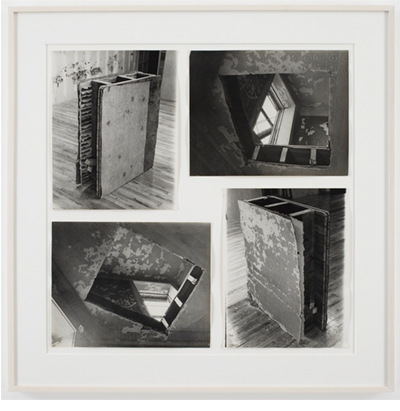
BRONX FLOOR FLOOR HOLE 01 Gordon Matta-Clark Bronx Floor: Floor Hole, 1972 courtesy of the Estate of Gordon Matta-Clark and David Zwirner Gallery (Click for slideshow)

In 1975 the young American artist Gordon Matta-Clark took a chainsaw to a perfectly ordinary single family house in Englewood, New Jersey and split it in two. While the stunt smacked of bad-boy behavior and art world sensationalism, it was hardly an act of anarchy or desperation. Rather, it was the intervention of an artist with the keenest sensitivities renouncing commercialism in search of a more elemental understanding of space and materials.
A new exhibit at the David Zwirner Gallery collects artworks from 112 Greene Street, the legendary gallery Matta-Clark founded in SoHo in 1970. That space became a haven for a vibrant, eclectic group of New York artists who gathered, debated, performed, and exhibited there. This survey, which includes many pieces by Matta-Clark himself, brings that world richly to life and illuminates the themes of his work, themes that are as resonant today as they were forty years ago.
Educated as an architect, Matta-Clark left the profession to create sculptures, installations, films and photographs that often employed architectural forms and materials in unorthodox, unsettling ways. His most famous works are “cuttings,” strategic slicings, removals, and recombinations of parts of existing buildings.
(more…)
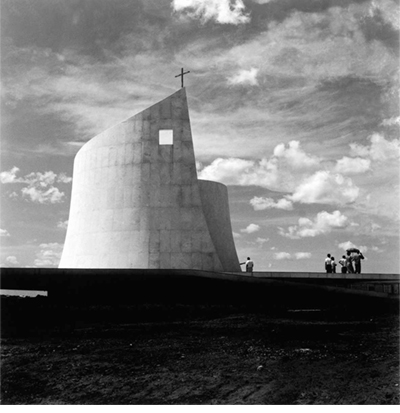
Click for slideshow

The fiftieth anniversary celebrations for the capital city of Brasilia in 2010 were an occasion for many to comment on its operational and design deficiencies, as well as those of the Brazilian government itself. In an earlier piece about the anniversary we noted how demographic shifts have challenged the city’s original master plan. These sorts of discussions, while necessary, tend to obscure the city’s ambitious, Utopian origins. Brasilia’s designers, urban planner Lucio Costa and architect Oscar Niemeyer, had shaped it to embody the most progressive political, social, and aesthetic concepts. A new book of photographs by Marcel Gautherot, “Building Brasilia,” that documents the city’s construction and early years, evokes these ideals with great power.
Gautherot was a Paris-born photographer who trained as an architect and worked as an ethnographic photographer in the 1930’s, traveling within Mexico and Brazil to document traditional cultures. After serving in the French army in Senegal during World War II, he returned to Brazil and began a photography practice. There he crossed paths with Niemeyer, who would begin working with Costa on plans for the new city in 1956. At Niemeyer’s encouraging, Gautherot visited Brasilia repeatedly as it was under construction from 1957 to 1960, and then again several times in the 1970’s. While the bulk of his photographic oeuvre is comprised of ethnographic work, Gautherot’s photographs of Brasilia offer a thorough, cohesive portrait of the new city.
(more…)
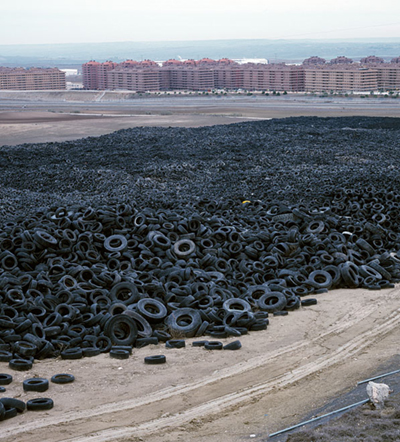
(Click to enlarge)

Seseña Nuevo is a deserted mini-city built some 40km from Madrid, in the middle of a barren landscape. Also known as “Francisco Hernando Residential” after its constructor, this phantasmagorical site hosts 13,508 flats. The site was built without any regard for urban planning or basic amenities, such as water and public transportation. Seseña Nuevo began rising from the ground in the year 2000, during the construction boom that took place in Spain. Perhaps it was Francisco’s hope that the angry voices of the buyers of his flats would be enough to force the authorities to accept the new landscape and bring all the basic public services to this new city. However, this was not the case: it turns out that in 2009 only 3,000 houses had been sold to some unlucky speculators. Approximately 2,000 of the apartments have been transferred to the property of banks as credit payment. The lack of legal guarantors and the fierce reaction of local authorities have frustrated Francisco’s intentions and made Seseña Nuevo the symbol of speculation in Spain. For those driving down highway A4, towards Toledo, this useless mass of concrete will loom in the horizon for years to come.
(more…)
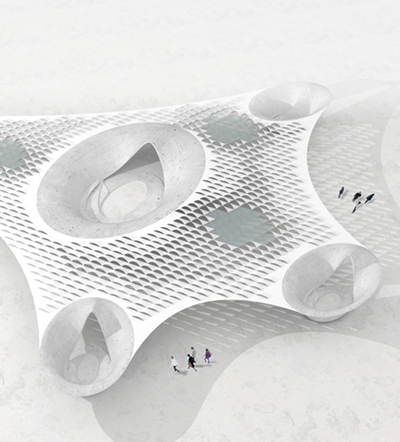
(Click to enlarge)

Designers Matt Johnson and Jason Logan cite “Prism Cloud” as an example of their aim to use sustainable technologies as tools for creating transformative experiences. As colleagues at the University of Houston College of Architecture, they have collaborated on this solar energy entrant in the Land Art Generator Initiative with several objectives in mind.
“Our goal was to make a project that would be simple to install, compelling as an experiential space, and that would generate energy without appearing explicitly infrastructural,” explains Johnson.
One of the major criticisms leveled against any large-scale installation of solar panels is the sheer size of the footprint. The monumental solar field proposed for Deming, New Mexico, for example, will cover more than 3,000 acres of surface area upon its completion. So while there are environmental benefits to be gained from any photovoltaic-based source of electricity, “Prism Cloud” offers a lighter touch: it consists of malleable, thin-film solar cells strung together by cable and suspended cloud-like above the ground as a canopy, held aloft only by a series of structural concrete piers (or oases). The lightness of the physical footprint atop the earth’s surface makes this an appealing proposal, but it is a different form of light altogether that turns this energy generator into a genuine piece of land art.
(more…)
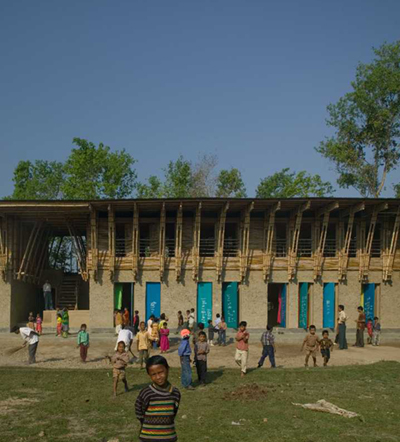
METI – Handmade School. Rudrapur, Bangladesh. 2004-06. By Anna Heringer and Eike Roswag. Image: Kurt Hörbst (Click to enlarge)

Over the last eight decades the architecture department at the Museum of Modern Art made its reputation by promoting avant-garde European and American work, mounting exhibits that defined and championed movements like the International Style, Postmodernism, and Deconstructivism. So MoMA’s new architecture exhibit “Small Scale, Big Change,” which focuses on modestly scaled, community-centered projects around the world, marks a dramatic shift in their mission.
It also serves as a potent call to arms. Architects everywhere today are challenged by economic instability and environmental concerns and, at the tail end of modernism, searching for a meaningful, unified language with which to build. The projects at MoMA suggest that the solution isn’t a new set of forms, but a new way to conceive and orchestrate building and infrastructure projects.
The eleven projects on display are truly global, and include works in Africa, South America, South Asia, and the Middle East. None was designed by a “starchitect,” and all were implemented in close collaboration with civic and community groups. Most significantly, each project grew out of real practical and social needs. One of the most powerful designs in the show is an American house prototype that costs only twenty thousand dollars. Two other projects, a primary school in Bangladesh and a linear park for Rio de Janeiro, were developed in direct response to community requests.
(more…)
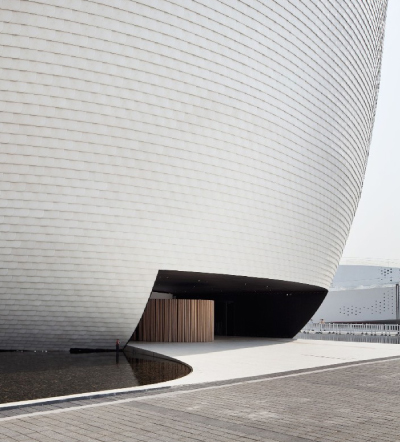
Finland's Shanghai Expo Pavilion, “Kirnu,” by JKMM (Finland), 2010. Photo: Derryck Menere. (Click to enlarge)

When the San Francisco Museum of Modern Art chose the Oslo-based architecture office Snohetta to design its addition this summer, it heralded the arrival of a great new wave of Nordic design. Not since the 1960’s, when Americans were lounging around in Verner Panton chairs and Marimekko dresses, has the voice of designers in Denmark, Finland, Iceland, Norway and Sweden been so prominent internationally.
An exhibit at Scandinavia House in New York, “Nordic Models + Common Ground: Art and Design Unfolded,” presents a small, intriguing selection of art and design projects. The unique character of modern Nordic design, a formal purity enlivened by gentle eccentricities, has often been attributed to the region’s isolating, rugged geography. Yet even in our present age of global connectedness these qualities remain evident. Each project on display combines forms and materials in unlikely ways. Yet even the strangest of them — like a rap song that outlines urban planning strategies, and light fixtures crafted from the dried skins of codfish — have a palpable warmth: they aren’t ironic.
In addition, each work on display has a startling formal simplicity, which owes less to a minimalist aesthetic than to the designer’s clarity in concept and economy in execution. This is especially remarkable in the architecture projects. A basic triangular tent module is arrayed to shape an exhibition pavilion. Another, spherical pavilion is clad entirely with flat, scale-like, composite wood shingles.
(more…)
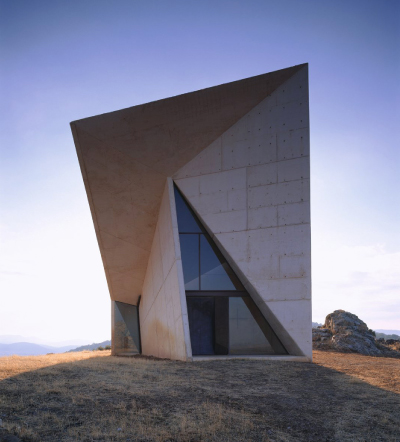
Chapel, Valleaceron, Spain, 2001. By Sancho Madridejos Architecture Office, from Closer to God, Copyright Gestalten 2010. (Click image to enlarge.)

The controversy over the construction of an Islamic cultural center near Ground Zero is surprising when one remembers that New York City is already rich with churches, temples, mosques, and storefronts selling supplies for vodun and santeria rites. It’s hard to remember when another building has caused such a fuss. What is it about this structure, which isn’t even a proper mosque, that stirs up such strong emotions? At a time when our culture seems to have become largely secular, how can a religious building still be regarded with talismanic powers?
A new book that looks at contemporary houses of worship, “
Closer to God: Religious Architecture and Sacred Spaces,” takes up that very question. The structures pictured are eclectic in style, scale, materials, and in the different religions they shelter. There’s a one-person meditation hut in rural New England, an intimate Buddhist shrine in Kyoto, and an auditorium-sized cathedral in Rome. There are churches poured in rough concrete, others built with engineered glass curtain walls, and one clad in battered zinc panels.
If there’s anything these buildings have in common it’s the way that they employ pure geometries and natural light to evoke a spiritual dimension. In this sense, contemporary architects are following in the footsteps of their ancient counterparts. The use of idealized geometries like squares and circles, and the dramatic manipulation of daylight, are practices characteristic of traditional Judeo-Christian and Islamic architecture.
(more…)

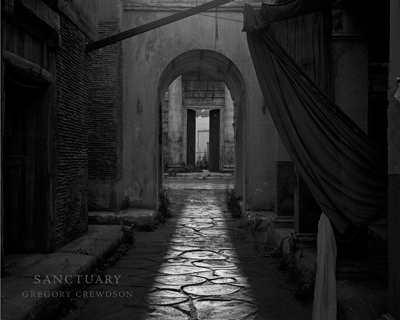
Sanctuary Cover, All photography by Gregory Crewdson. (Click images to enlarge)


Photographer
Gregory Crewdson is known for his staged tableux of everyday suburban scenes. He uses movie lighting and post-production effects to compose dramatically lit and colored images that, in their heightened realism, verge on the surreal. They’re physically accurate and emotionally unsettling, without easy sentimental meaning.
For his latest project, in an interesting reversal, Crewdson documented the exterior stage sets at
Cinecittà, the fabled movie studio in Rome. He worked in a more straightforward way, almost documentary-style, shooting in black and white and using natural light. These stately, evocative prints have been collected in a new book,
Sanctuary, and are on view at the
Gagosian Gallery on Madison Avenue in New York from September 23 through October 30.
What’s most striking about the scenes is their emptiness. There are no people here and no traces of them: no signage, no litter, no footprints or tire tracks. And yet the architecture of the sets invites occupation. There are plazas, walkways, and triumphal arched entryways. Where has everyone gone? As in the cityscapes of Giorgio DeChirico, the place seems to have been abandoned all at once, frozen in a historic moment by illness or catastrophe. Elements like half-open doors and stairs that lead nowhere have a dream-like resonance.
(more…)

![]()




 Facebook
Facebook Permalink
Permalink Digg
Digg Reddit
Reddit LinkedIn
LinkedIn StumbleUpon
StumbleUpon Tumblr
Tumblr












